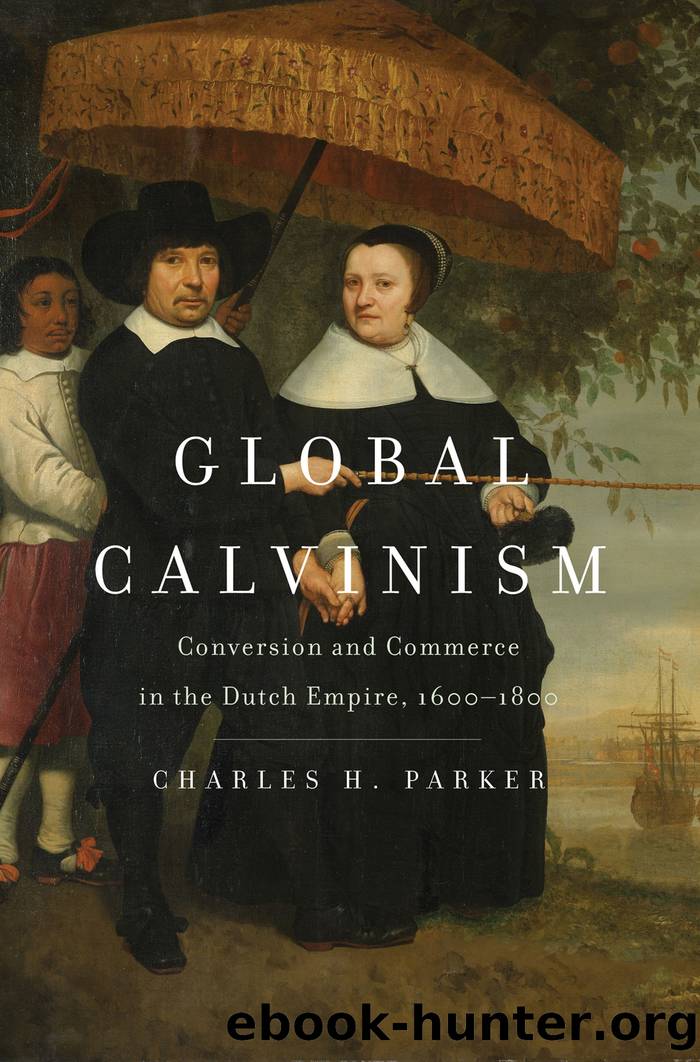Global Calvinism by Charles H. Parker;

Author:Charles H. Parker;
Language: eng
Format: epub
Publisher: Yale University Press
Published: 2021-06-15T00:00:00+00:00
CONCLUSION
Ironically, the marks the Dutch left in the linguistic fields of the early modern world were vernacular footprints put down by ministers and native linguists. As a language of empire and missions, Dutch never really got off the ground in any VOC or WIC holdings, except at the Cape of Good Hope in the late eighteenth century. In the towns of Cape Town, Drakenstein, and Stellenbosch, Afrikaans began to emerge as a distinct language from the pidgin Dutch spoken among a growing population of European settlers. Generally, however, the territories of the Dutch empire in the period of company rule were kept deliberately small, spatially diffuse, and sparsely populated with Dutch settlers, factors that counteracted a Dutch language policy. The VOC and WIC, in any case, supported such a policy only with ambivalence and inconsistency. The most potentially potent means for inculcating the Dutch language were the instruments of the Calvinist mission: schools, churches, and religious media. Yet the Protestant translation culture of vernacularizing the journey to salvation and sanctification stood at odds with the imperial project of promoting loyalty to the company through language and culture.
Dutch predikanten schooled in Protestant universities and formed in Calvinist intellectual circles absorbed the translation cultures of the Renaissance and Reformation. Steeped in a humanistic ethos, ministers set up schools that focused on transmitting Protestant principles in young minds through a literary education. Translators placed a premium on theological precision, which often sparked fierce, persistent, and acrimonious personal quarrels. In these schools and in their translation work, predikanten worked with native linguists to identify the relationship between a mother tongue and local idioms. This effort stemmed from their understanding of the relationship between Latin and national vernaculars. On every occasion except the conflict over High or Low Malay in Bible translation, missionary linguists opted for what they regarded as the vernacular of the people or ânationââSinkan in Formosa, Tamil and Sinhalese in Ceylon and South Asia. Often Portuguese stood in for a national vernacular. In pursuing this linguistic strategy, Dutch Calvinists operated in continuity with the Protestant translation culture of the Reformation that prized vernacular translation. In the Leijdekker-Valentijn debate, the humanist commitment to an elite classical form triumphed so that Calvinists could present scripture to Muslim elites in as compelling language as possible. The disputes over how to convert pagans and Moors, how to distinguish between religious demand and cultural adiaphora, and how to transmit the word of God across languages exerted far-reaching influences on Protestantism in Europe.
Download
This site does not store any files on its server. We only index and link to content provided by other sites. Please contact the content providers to delete copyright contents if any and email us, we'll remove relevant links or contents immediately.
| Belgium | France |
| Germany | Great Britain |
| Greenland | Italy |
| Netherlands | Romania |
| Scandinavia |
Room 212 by Kate Stewart(4721)
The Crown by Robert Lacey(4560)
Endurance: Shackleton's Incredible Voyage by Alfred Lansing(4478)
The Iron Duke by The Iron Duke(4103)
The Rape of Nanking by Iris Chang(4005)
Killing England by Bill O'Reilly(3893)
Joan of Arc by Mary Gordon(3769)
Say Nothing by Patrick Radden Keefe(3707)
I'll Give You the Sun by Jandy Nelson(3257)
Shadow of Night by Deborah Harkness(3163)
Hitler's Monsters by Eric Kurlander(3148)
Blood and Sand by Alex Von Tunzelmann(3045)
Mary, Queen of Scots, and the Murder of Lord Darnley by Alison Weir(3042)
Darkest Hour by Anthony McCarten(3011)
Margaret Thatcher: The Autobiography by Thatcher Margaret(2965)
Eleanor & Park by Rainbow Rowell(2929)
Red Famine: Stalin's War on Ukraine by Anne Applebaum(2807)
Book of Life by Deborah Harkness(2708)
The One Memory of Flora Banks by Emily Barr(2677)
